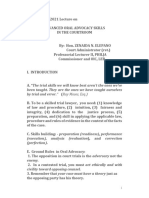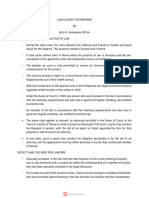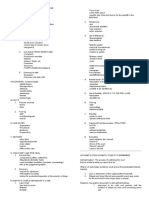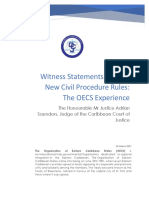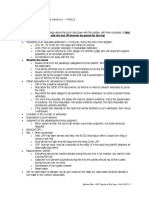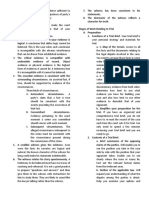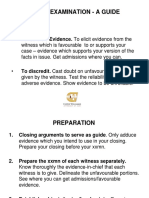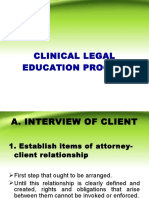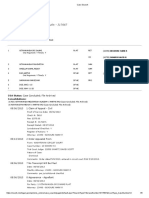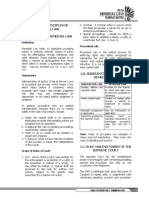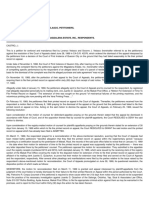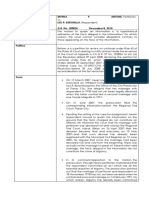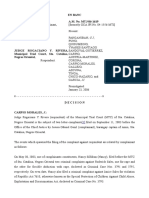Civil Notes
Close of Pleadings
They close 14 days after reply to Soc.
O18 R19 comes into effect ,
All documents then put together in a bundle , these documents are then put in one
collective document. The document is then filed in court and served on all other
defendants .
When ths process is done then P moves to the next stage.
At this stage it is only allegations and response to allegations .
They are basic allegations.
Basic Rule in Civil Law is that each side is entitled to know in adance the allegations
they have to meet at trial but not evidence that the other party intends to adduce.
Is there any way to find out not all but some of the Evidence.
Disclosure of Evidence
These need to be examined in two statges :
1. Preaction Discoveries.
2. Discovery between parties after the action has commeneced.
PRE-ACTION Discoveries.
Example: As a result of the accidednt one of the drivers suffred injuries and amnesia.
Can that driver go to court and ask te other driver in the accident to tell how and
why it happened?
The chances of success in this situation is next to nothing.
Why CAN’T THE DRIVER QUESTION AS TO WHY IT HAPPENED?
Because of the right to remain silent and protect himself from self-incrimination.
After Discovery
Master will give directions on process for trial
O25 HCR
Discuss the file before appearing for summoms for directions.
The Mode of Trial
Supboena ad testificandum – This is for a person to appear in person and testify
Supboena duecus tecum- this is where documents are provided, tp bring a file
and ta;k from that
7 days before the hearing O 38 HCR
Has an endorsement attached at the bottom
Supbeoan is only valid for 12 weeks
O 39 R1
�Opening Address for Plaintiff
Out line the brief chronology of the case .
If the court does not have a recording device jot down on the page the
chronology.
Max 10 bullet points.
List your allegation and bring it to the attention f the judge where parties
agree and disagree.
Point out the difference and bring in the evidence that it was the other
party resp for the accident
Refer to the judge the correspondence agreed by the parties and note
down the agreements nd disagreements of parties in that
correspondence.
Outline to the udge the number of witness P will call.
The impotant thing to highlight is the expert witnesses which will be done
at the end .
The expert will talk about injuries and not about how it happened.
The experts come at a huge price.
Extract from the expart wheter its his first time or they have done so
previously
Also ask for how many years .
Ask whether the expert has given statement for plaintiff only or for the
defendant as well
EIC- if you are thouroughly prepared there should be no surprises .
Never ask a question from your witness to which you yourself know the
answer.
CROSS EXAMINATION
You can ask leading question
This is done to break the witness down.
Put the opponents witness at unease, means intimidating
Your body language is an important component.
As a cross examiner your body language has to be diffrerent.
In cross examination you want the witness to agree with what you are
saying.
Cross examination ios designed to destroy the witness , to try and
unsettle, unnerve , intimidate the witness.
Everything to be done within the fine line.
In cross you should have recorded the EIC .
Like EIC the cross is also in stages
Cross examiner should be following the evidence upclsoe.
Don’t be afraid to ask leading questions.
Don’t be afraid to put the question to the witness.
Show that you are incharge.
AS cross examiner you will also encounter civ witnesses who may not be
easily moveable, don’t get angry but rather change technique and sk
follow up questions.
The hardest people to cross examine are expert witnesses.
� They are usual;ly more experienced and harder to shift.
Use your own witness question to find loop hole on other party questions
Use relevant exhibits.
If there is a medical research
Never ask a witness to explain or repeat the evidence .
Always know what the answer the witness is going to give
Don’t be surprised at the answers
Listen to the answer and look directly in the face of the witness when she
or he answers.
Never ask for an opinion or conclusion.
Golden Rule is do not argue with the witness
Always control ad dominate the witness.
Have a plan and follow that
Structure the order of the questions.
RE EXAMINATION
Should be reasonably short.
Most things covered in EIC
If any answer needs clarity during cross you can do so in re examination.
Max 4 quest
Golden Rule: If you have forgotten something in EIC you can not ask yor
client duing re – examination.
Its always there to clarify questions in cross.
Not to introduce new matters.
NO CASE TO ANSWER
The judge take an undertaking
only CIV judge has the authority
The Golden Rule: You do not make a submission of NO CASE TO ANSWER.
At the end there is closing speeches whereby each side will close
submissions.
APPEALS
It rests with the Court of Appeal
For Fiji, instead of Privy council we have Supreme Court
COA sits about 4 times a year, Supremem Court sits about 1 or two ties a
year
Appeal is not a substantive right, it is a right given by statue and not
common law .
A court cannot assume an appellate role unles given by statue .
Most countries have written constitutions.
High Court Atct
COA Act
WHAT IS AN APPEAL
I s a procecuddure where the unsuccessful party
Rule 6 COA Rules
Rule 7 COA
IN HC there is different form for different things and that is in the
prescribed in the forms.
� The COA Rules also provde for rules
Where forms are prescribed it should be used.
NON Compliance with the rules may be waived by the COA , the
Presidendent will allow it to be remedied.
From interlocutory judgemment there isn’tt a righ to appeal
Final judgement has a right to appeal.
In Fiji you have 21 dys from judgement to seek leae for appeal , O16 of
COA Act .
It is heard by a singke judge .
The reseident Justice of Appeal
Loga Nandan Pillay
There is a three fold test
1. The evidence must be fresh.
The evidence is such as it would have a substantial effecect
It must be credible.
JUDICIAL REVIEW
Dates back to the days of kings and queens.
JR is remedy in public law
Law of contract and tort are examples of private law \
An employee working ex for carpentars group







